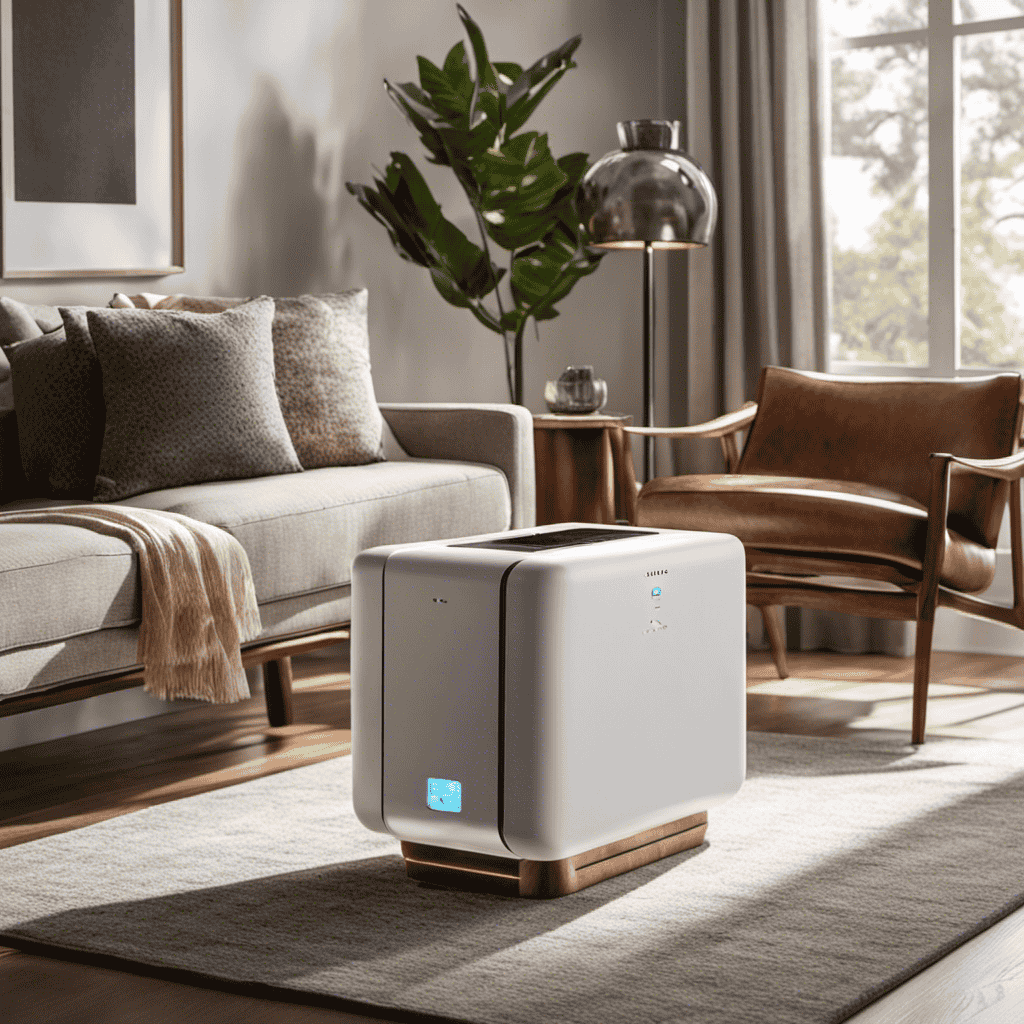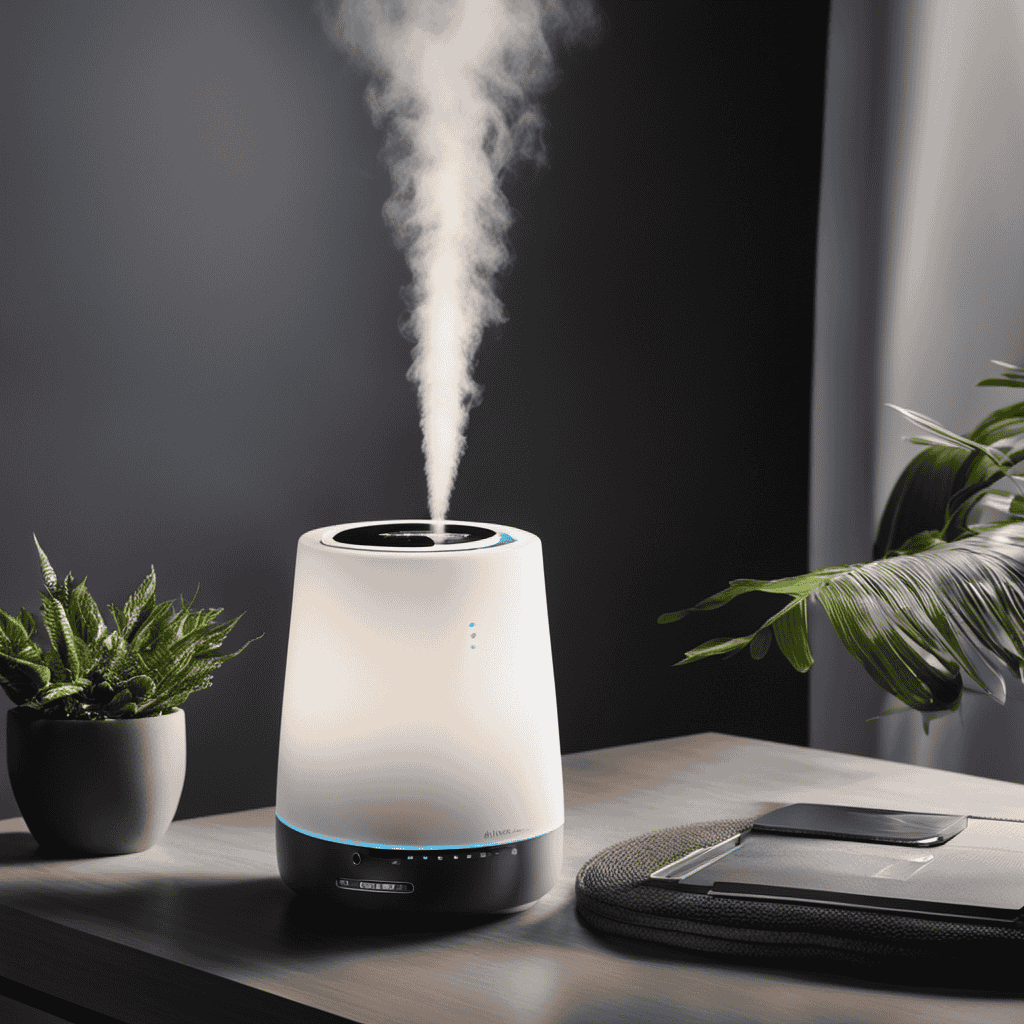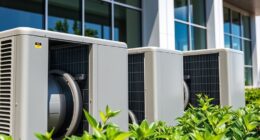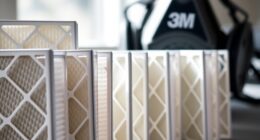I am curious about ozone air purifiers as someone who appreciates clean and fresh air. These devices are said to be effective in enhancing indoor air quality, but what are they exactly and how do they function?
In this article, I’ll delve into the world of ozone air purifiers, exploring their benefits, misconceptions, and even their impact on allergy relief. Let’s uncover the truth behind ozone air purifiers and how they can contribute to a healthier living environment.
Key Takeaways
- Ozone air purifiers use ozone to neutralize and eliminate airborne contaminants, such as bacteria, viruses, and odors.
- They significantly improve air quality by eliminating harmful pollutants like smoke, dust, and pet dander, and have powerful odor elimination capabilities.
- Ozone air purifiers can reduce allergens in the air, making them beneficial for individuals with allergies or respiratory conditions.
- However, there are potential health risks associated with ozone air purifiers, as prolonged exposure to high levels of ozone can worsen pre-existing respiratory conditions. Safer and more effective alternatives include HEPA filters, activated carbon filters, UV-C light technology, and electrostatic precipitators.
How Does an Ozone Air Purifier Work
To understand how an ozone air purifier works, you need to know that it uses ozone to neutralize and eliminate airborne contaminants.
Ozone, or O3, is a highly reactive gas that is produced by the ozone air purifier technology. It works by emitting ozone into the air, which then reacts with pollutants such as bacteria, viruses, and odors. This reaction breaks down the pollutants at a molecular level, rendering them harmless.
The ozone air purifier maintenance is relatively simple. It usually involves cleaning the unit and replacing the ozone generator if necessary. It is important to follow the manufacturer’s instructions for proper maintenance to ensure optimal performance.
Ozone air purifiers are effective in improving indoor air quality, but it is essential to use them in well-ventilated spaces and follow safety guidelines to avoid excessive ozone exposure.
Benefits of Using an Ozone Air Purifier
Using an ozone air purifier offers several notable benefits.
Firstly, it significantly improves air quality by eliminating harmful pollutants, such as smoke, dust, and pet dander.
Additionally, these purifiers have powerful odor elimination capabilities, effectively removing unpleasant smells caused by cooking, tobacco, and pets.
Lastly, ozone air purifiers have the potential to reduce allergens in the air, making them an excellent choice for individuals with allergies or respiratory conditions.
Improved Air Quality
You can improve the air quality in your home by using an ozone air purifier. These devices are designed to remove pollutants from the air, resulting in cleaner and healthier indoor environments.
Here are some ways in which an ozone air purifier can contribute to improved air quality:
-
Enhanced air circulation: Ozone air purifiers work by emitting ozone, a highly reactive molecule that breaks down pollutants in the air. This process helps to improve air circulation and prevent the buildup of harmful particles.
-
Reduction of allergens and irritants: Ozone air purifiers are effective in removing allergens such as pollen, dust mites, and pet dander from the air. By reducing these irritants, they can provide relief for individuals with respiratory conditions like asthma or allergies.
-
Elimination of odors: Ozone is known for its ability to neutralize odors. An ozone air purifier can effectively eliminate unpleasant smells caused by cooking, pets, or smoke, resulting in fresher indoor air.
Using an ozone air purifier can have a significant positive impact on respiratory health by improving air circulation, reducing allergens, and eliminating odors.
Odor Elimination Capabilities
When looking for ways to eliminate odors, consider the capabilities of an ozone air purifier. These devices are highly effective at improving indoor air quality and eliminating pet odors. Ozone, a powerful oxidizing agent, is released into the air by the purifier. It breaks down odorous molecules and neutralizes them, leaving the air fresh and clean. The table below highlights some key features of ozone air purifiers:
| Features | Benefits |
|---|---|
| Removes pet odors | Provides a clean and fresh-smelling home |
| Eliminates other household odors | Creates a more pleasant living environment |
| Reduces allergens and pollutants | Improves overall indoor air quality |
| Helps eliminate bacteria and viruses | Promotes a healthier living space |
Incorporating an ozone air purifier in your home can greatly enhance the air quality and eliminate pet odors, making your living space more comfortable and enjoyable.
Allergen Reduction Potential
The ozone air purifier greatly reduces allergens and improves indoor air quality. Ozone air purifiers are known for their effectiveness in removing allergens from the air. Here are three key allergen reduction techniques used by ozone air purifiers:
-
Ozone Generation: Ozone is a powerful oxidizing agent that can break down and eliminate allergens such as pollen, dust mites, and pet dander. Ozone molecules attach to these allergens and neutralize them, rendering them harmless.
-
HEPA Filtration: Ozone air purifiers often incorporate High-Efficiency Particulate Air (HEPA) filters. These filters can capture tiny particles, including allergens, as small as 0.3 microns in size. HEPA filters work by physically trapping allergens in their dense fibers.
-
Ionization: Ozone air purifiers can also produce negative ions that attach to allergens in the air, causing them to become heavy and fall to the ground or stick to surfaces, effectively removing them from the air you breathe.
Understanding the Ozone Layer and Its Relation to Air Purification
Understanding the ozone layer and its relation to air purification is crucial for comprehending the effectiveness of ozone air purifiers.
The ozone layer, located in the Earth’s stratosphere, plays a vital role in shielding us from harmful ultraviolet (UV) radiation. However, due to human activities, such as the release of chlorofluorocarbons (CFCs), the ozone layer has been depleted. This depletion allows more UV radiation to reach the Earth’s surface, leading to various environmental and health concerns.
Ozone air purifiers utilize ozone air purifier technology to generate ozone molecules, which are known to have powerful oxidation properties that can neutralize pollutants and eliminate odors.
However, it is important to address common misconceptions about ozone air purifiers to fully understand their benefits and limitations.
Common Misconceptions About Ozone Air Purifiers
You might have heard some misconceptions about how ozone air purifiers work and their effects on indoor air quality. Let me clear some things up for you.
Ozone air purifiers are devices that produce ozone, a molecule made up of three oxygen atoms, to clean the air. Contrary to popular belief, ozone air purifiers do not filter out particles like dust or allergens. Instead, they work by releasing ozone into the air, which reacts with pollutants and neutralizes them.
However, there are a few misconceptions surrounding ozone air purifiers that need to be addressed:
-
Ozone air purifiers are not safe for humans and pets: While high levels of ozone can be harmful, ozone air purifiers are designed to emit safe levels of ozone that do not pose a risk to human health or pets.
-
Ozone air purifiers eliminate all indoor pollutants: Ozone air purifiers are effective at neutralizing certain types of pollutants, such as odors and volatile organic compounds (VOCs). However, they may not be as effective at removing other types of pollutants, such as dust and allergens.
-
Ozone air purifiers are a replacement for traditional air purifiers: Ozone air purifiers should not be used as a sole means of air purification. They are best used in conjunction with traditional air purifiers that use filters to remove particles from the air.
It is important to understand the limitations and benefits of ozone air purifiers before deciding to use one in your home.
The Difference Between Ozone Air Purifiers and Other Types of Air Purifiers
Contrary to popular belief, ozone air purifiers and other types of air purifiers differ in their approach to cleaning the indoor air. While most air purifiers, such as HEPA filters, rely on physical filtration to remove particles from the air, ozone air purifiers use ozone molecules to neutralize odors and kill bacteria. This fundamental difference in technology has important implications for improving indoor air quality.
To better understand the difference, let’s compare ozone air purifiers with HEPA filters in terms of their cleaning mechanisms:
| Ozone Air Purifiers | HEPA Filters |
|---|---|
| Release ozone molecules into the air to eliminate odors and kill bacteria | Trap microscopic particles in a filter, preventing them from circulating in the air |
| Can be effective in reducing certain types of odors and pollutants | Highly efficient in removing airborne particles, including allergens and dust |
| May produce ozone as a byproduct, which can have potential health risks | Considered safe and recommended by experts for improving indoor air quality |
As we can see from the table, ozone air purifiers and HEPA filters have different strengths and weaknesses when it comes to cleaning the indoor air. However, it is important to note the potential health risks associated with ozone air purifiers, which will be discussed in the subsequent section.
Potential Health Risks Associated With Ozone Air Purifiers
Ozone lung damage and the link between ozone and respiratory problems are key points to consider when discussing the potential health risks associated with ozone air purifiers. Ozone, a highly reactive gas, can cause damage to the lungs when inhaled, leading to respiratory issues and long-term health complications.
Asthma worsened by ozone is another important consideration. For individuals with asthma, exposure to ozone can exacerbate symptoms and make it harder to breathe. This can have a significant impact on their quality of life and overall respiratory health.
Understanding these connections is crucial in evaluating the safety and effectiveness of ozone air purifiers. It is important to weigh the potential benefits of these purifiers against the potential risks they pose to respiratory health. By considering the impact of ozone on lung damage, asthma, and respiratory problems, we can make informed decisions about the use of ozone air purifiers and prioritize the health and well-being of individuals.
Ozone Lung Damage
Be aware that excessive exposure to ozone can cause lung damage. Ozone is a harmful gas that can be found in the Earth’s atmosphere, but when it is present at ground level, it can have detrimental effects on our health.
Here are some key points to consider regarding ozone lung damage:
- Ozone can irritate and inflame the lining of the lungs, leading to respiratory issues.
- Prolonged exposure to high levels of ozone can worsen pre-existing respiratory conditions, such as asthma.
- Ozone can trigger asthma attacks and make it harder for individuals with asthma to breathe.
- The severity of lung damage caused by ozone depends on factors such as the concentration and duration of exposure.
- It is crucial to limit exposure to ozone, especially for vulnerable populations such as children, the elderly, and individuals with respiratory conditions.
Remember to take necessary precautions and avoid excessive exposure to ozone to protect your lung health.
Asthma Worsened by Ozone
After discussing the potential lung damage caused by ozone, let’s now shift our focus to how ozone can worsen asthma symptoms.
As someone who has been researching asthma treatment options, I find this topic particularly relevant. Ozone therapy, which involves the use of ozone to treat various medical conditions, has gained attention in recent years. However, studies have shown that exposure to high levels of ozone can trigger asthma attacks and make breathing more difficult for asthma sufferers.
Ozone irritates the airways and inflames the lungs, leading to increased coughing, wheezing, and shortness of breath. It is crucial for individuals with asthma to be aware of the negative effects of ozone and take necessary precautions to minimize exposure.
Ozone and Respiratory Problems?
Are you aware of the potential connection between high levels of ozone and respiratory problems?
Ozone, a gas composed of three oxygen atoms, can be harmful when present at high levels in the air we breathe. Research suggests that exposure to elevated ozone levels can lead to various respiratory conditions, including asthma and other lung diseases.
It is important to note that while ozone air purifiers are often marketed as a solution for improving indoor air quality, they can actually worsen respiratory conditions. Here are three key points to consider regarding ozone air purifiers and lung health:
- Ozone air purifiers can generate ozone as a byproduct, which can irritate the respiratory system.
- Prolonged exposure to ozone can lead to inflammation in the lungs and worsen respiratory conditions.
- To improve lung health and reduce the risk of respiratory problems, it is recommended to choose air purifiers that do not produce ozone or opt for alternative methods of improving indoor air quality.
How to Choose the Right Ozone Air Purifier for Your Needs
When choosing the right ozone air purifier for your needs, it’s important to consider the size of the room you will be using it in. The ozone production capacity of an ozone air purifier determines its effectiveness in removing pollutants from the air.
With advancements in ozone air purifier technology, newer models are now more efficient and powerful in purifying the air. However, it is crucial to regularly maintain your ozone air purifier to ensure its optimal performance. This includes cleaning or replacing the filters, monitoring the ozone output, and following the manufacturer’s instructions.
Additionally, it’s worth noting that ozone air purifiers consume energy, so it’s important to choose an energy-efficient model to minimize the impact on your energy consumption.
The Effectiveness of Ozone Air Purifiers in Eliminating Odors
One key factor to consider when evaluating the effectiveness of ozone air purifiers in eliminating odors is the size of the room they are being used in. The size of the room directly affects the concentration of ozone that can be achieved, as ozone dissipates more quickly in larger spaces.
Other factors to consider include the duration of ozone exposure and the source of the odor. Ozone air purifiers work by releasing ozone molecules into the air, which react with and neutralize odor-causing particles.
However, it is important to note that ozone can have long term effects on human health and should be used with caution. To ensure an improved indoor environment, it is recommended to follow manufacturer instructions, use ozone air purifiers in properly ventilated areas, and limit exposure to ozone.
Ozone Air Purifiers and Their Impact on Indoor Air Quality
When it comes to evaluating ozone’s effectiveness as an air purifier, it is important to consider its ability to remove pollutants and eliminate odors.
However, it is also crucial to be aware of the potential health risks associated with ozone exposure, such as respiratory irritation and lung damage.
As a result, exploring alternative air cleaning methods that are equally efficient but safer for human health is necessary for maintaining indoor air quality.
Ozone’s Effectiveness as Purifier
If you’re looking for an effective air purifier, ozone may not be the best choice. While ozone air purifiers are marketed as effective in removing pollutants from the air, their effectiveness is questionable.
Here are a few reasons why:
-
Ozone air purifiers primarily work by releasing ozone gas, which reacts with pollutants in the air. However, the effectiveness of this process is limited and may not fully eliminate all pollutants.
-
Ozone air purifiers have safety precautions that need to be followed strictly. Ozone gas can be harmful to humans and pets, causing respiratory issues and other health problems.
-
Ozone air purifiers can produce harmful byproducts, such as formaldehyde and ultrafine particles, which can further worsen indoor air quality.
Considering these factors, it is important to carefully weigh the potential benefits and risks before choosing an ozone air purifier.
Now let’s explore the potential health risks associated with ozone air purifiers.
Potential Health Risks
To protect yourself and your loved ones, it’s important to be aware of the potential health risks associated with using an ozone air purifier. While these devices are marketed as effective at removing pollutants from the air, they also emit ozone, which can have harmful effects on our health. Ozone is a highly reactive gas that can irritate the respiratory system and exacerbate conditions such as asthma and allergies. In fact, the Environmental Protection Agency (EPA) has set ozone air purifier regulations to limit the amount of ozone these devices can emit. Some common side effects of ozone exposure include coughing, chest pain, and shortness of breath. It’s crucial to consider these risks before using an ozone air purifier and explore alternative air cleaning methods that are safer and more effective.
| Potential Health Risks of Ozone Air Purifiers |
|---|
| Irritation of respiratory system |
| Exacerbation of asthma and allergies |
| Coughing, chest pain, and shortness of breath |
In the next section, we will discuss alternative air cleaning methods that can effectively purify the air without the potential health risks associated with ozone air purifiers.
Alternative Air Cleaning Methods
One option you can consider is using a HEPA filter to effectively clean the air without the potential health risks associated with ozone air purifiers. HEPA stands for High Efficiency Particulate Air, and these filters are designed to capture and remove small particles from the air.
Here are some alternative air cleaning methods to consider:
- Activated Carbon Filters: These filters are effective in removing odors, gases, and volatile organic compounds (VOCs) from the air.
- UV-C Light Technology: This method uses ultraviolet light to kill bacteria, viruses, and other microorganisms.
- Electrostatic Precipitators: These devices use an electric charge to trap and remove particles from the air.
Using alternative air purifiers, such as HEPA filters, can provide cleaner air without the potential risks associated with ozone air purifier technology.
The Environmental Impact of Ozone Air Purifiers
The ozone air purifiers have a significant impact on the environment. Environmental concerns arise from the use of ozone air purifiers due to their potential contribution to ozone depletion.
Ozone depletion refers to the reduction in the Earth’s ozone layer, which protects us from harmful ultraviolet (UV) radiation. Ozone air purifiers work by generating ozone molecules to eliminate odors and pollutants in the air. However, the release of ozone into the atmosphere can contribute to ozone depletion.
Ozone depletion is a serious environmental issue as it can lead to increased UV radiation reaching the Earth’s surface, which can have harmful effects on human health and ecosystems. Therefore, it is important to consider the environmental implications before using ozone air purifiers.
Can Ozone Air Purifiers Remove Airborne Pollutants
You can rely on ozone air purifiers to effectively remove airborne pollutants from your environment. Ozone air purifiers work by producing ozone, a molecule that can react with and neutralize various pollutants in the air.
Here are three ways in which ozone air purifiers improve air quality and remove toxic pollutants:
-
Ozone oxidation: Ozone molecules react with pollutants, such as volatile organic compounds (VOCs), bacteria, and viruses, breaking them down into harmless byproducts.
-
Odor elimination: Ozone can neutralize strong odors caused by smoke, pets, or cooking, leaving the air smelling fresh and clean.
-
Mold and mildew control: Ozone can inhibit the growth of mold and mildew by destroying their spores and preventing them from spreading.
By using ozone air purifiers, you can significantly improve the air quality in your environment by removing toxic pollutants.
In the next section, we will discuss some tips for maintaining and cleaning an ozone air purifier.
Tips for Maintaining and Cleaning an Ozone Air Purifier
To keep your ozone air purifier running efficiently, it’s important to regularly clean the filters and replace them as needed. Maintaining ozone air purifiers is crucial for optimal performance and to ensure that they effectively remove pollutants from the air.
Cleaning ozone air purifiers involves removing the filters and gently washing them with mild soap and water. It’s essential to let the filters dry completely before reinserting them into the purifier. Additionally, the exterior of the purifier should be wiped down regularly to remove any dust or dirt that may accumulate.
By following these maintenance and cleaning tips, you can extend the lifespan of your ozone air purifier and ensure that it continues to provide clean and fresh air for your home.
Now let’s explore the role of ozone air purifiers in allergy relief.
Ozone Air Purifiers and Their Role in Allergy Relief
Using ozone air purifiers can help alleviate allergy symptoms by removing airborne allergens from the environment. These devices use ozone, a molecule made up of three oxygen atoms, to purify the air. Ozone works by oxidizing and neutralizing various pollutants, including allergens such as dust mites, pollen, and pet dander.
Here are three key ways ozone air purifiers contribute to allergy relief:
-
Elimination of airborne allergens: Ozone air purifiers effectively remove allergens from the air, reducing exposure and minimizing allergic reactions.
-
Odor elimination: Ozone is a powerful deodorizer that eliminates unpleasant smells, including those caused by mold, mildew, and pet odors.
-
Sterilization of germs and bacteria: Ozone has antimicrobial properties that can kill germs and bacteria, preventing the spread of infections and reducing the risk of respiratory illnesses.
Are Ozone Air Purifiers Safe for Pets and Children
As a researcher in the field of air purifiers, I’ve come across concerns regarding the safety of ozone air purifiers for pets and children.
It’s important to address this issue because the health and well-being of our loved ones, including our furry friends, should not be compromised.
In this discussion, we will explore the potential health risks involved and provide objective information to help make informed decisions about using ozone air purifiers in households with pets and children.
Pet and Child Safety
Pet and child safety is a top priority when using an ozone air purifier. It is important to take precautions to ensure their well-being.
Here are some key points to consider:
-
Keep pets and children out of the room when the ozone air purifier is in use. Ozone can be harmful to their respiratory systems, so it is best to avoid direct exposure.
-
Make sure to follow the manufacturer’s instructions regarding usage and safety guidelines.
By taking these steps, you can minimize any potential risks and ensure the safety of your loved ones.
However, it is also important to be aware of the potential health risks involved.
Health Risks Involved?
While ozone air purifiers can effectively remove odors and harmful pollutants from the air, it is important to consider the potential health risks involved. Ozone, a gas that is produced by these purifiers, can have detrimental effects on our health when inhaled in high concentrations or over a prolonged period of time. Exposure to ozone can cause respiratory issues, such as coughing, wheezing, and throat irritation. It can also trigger asthma attacks and worsen existing respiratory conditions. Furthermore, long-term exposure to ozone may lead to more serious health problems, including lung damage and decreased lung function. It is crucial to understand the dangers of ozone air purifiers and take necessary precautions to protect ourselves and our loved ones from these potential health risks.
| Dangers of Ozone Air Purifiers |
|---|
| 1. Respiratory issues |
| 2. Asthma attacks |
| 3. Worsening of respiratory conditions |
| 4. Lung damage |
| 5. Decreased lung function |
In the next section, we will delve into understanding the regulations and guidelines for using ozone air purifiers, which will help us make informed decisions regarding their usage.
Understanding the Regulations and Guidelines for Using Ozone Air Purifiers
To understand the regulations and guidelines for using ozone air purifiers, you should familiarize yourself with the recommended safety measures. Ozone air purifiers are regulated by various government agencies to ensure public safety and compliance with environmental standards.
Here are some key safety measures to consider:
- Always follow the manufacturer’s instructions and guidelines for proper use and maintenance of the ozone air purifier.
- Use ozone air purifiers in well-ventilated areas to prevent excessive ozone buildup.
- Limit exposure to ozone by using the purifier for short periods of time and avoiding prolonged exposure.
- Regularly clean and maintain the purifier to prevent the accumulation of dust and contaminants.
By adhering to these safety measures, you can ensure the effective and safe use of ozone air purifiers while minimizing potential health risks.
Frequently Asked Questions
Can Ozone Air Purifiers Remove Airborne Pollutants?
Yes, ozone air purifiers can remove airborne pollutants. They use ozone purification methods, which effectively eliminate contaminants by breaking down their molecular structure. However, it’s important to use ozone air purifiers in a well-ventilated space to avoid potential health risks.
Are Ozone Air Purifiers Safe for Pets and Children?
Ozone air purifiers can be harmful to pets and children. The ozone they produce can irritate the lungs and cause respiratory issues. It is important to consider the safety of these devices before using them in a household with pets or children.
What Are the Regulations and Guidelines for Using Ozone Air Purifiers?
Are there regulations and guidelines for using ozone air purifiers? Yes, there are. These rules ensure the safe and effective use of ozone air purifiers, protecting both humans and the environment from potential harm.
How Do Ozone Air Purifiers Contribute to Allergy Relief?
Ozone air purifiers can contribute to allergy relief by removing airborne allergens. However, they can also worsen respiratory health and trigger asthma attacks. It’s important to follow regulations and guidelines when using ozone air purifiers.
What Are the Potential Health Risks Associated With Ozone Air Purifiers?
Potential health risks associated with ozone air purifiers include respiratory issues, irritation of the eyes, throat, and lungs, and long-term effects on lung function. It’s important to consider these dangers before using such devices.
Conclusion
In conclusion, ozone air purifiers are a great option for improving indoor air quality. They work by producing ozone, which helps to eliminate odors and kill bacteria and viruses. One interesting statistic is that ozone air purifiers can remove up to 99% of airborne particles as small as 0.3 microns.
However, it is important to note that ozone can be harmful in high concentrations, so it is crucial to follow the regulations and guidelines for using ozone air purifiers. Overall, when used properly, ozone air purifiers can be an effective tool for maintaining a clean and healthy indoor environment.










